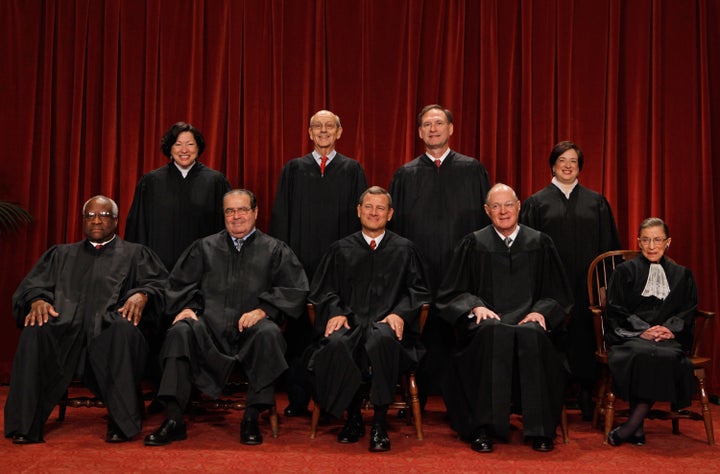
WASHINGTON -- Time and timing was of the essence Monday afternoon during Supreme Court oral argument over which legislative maps Texas may use in its fast-approaching state and federal primary elections, now slated for April.
The justices appeared to recognize that they needed to craft some creative compromise to avoid a hastily written, ideologically divided opinion that could essentially hand over the Texas legislature and four new congressional seats to Republicans at the expense of the state's increased Latino population, which primarily votes Democratic.
In light of the 2012 Census data, the Republican-controlled Texas legislature redrew its state and federal electoral districts. The Voting Rights Act of 1965 then required Texas, as one of a handful of states with a history of voter minority suppression, to preclear its redistricting plans with a federal court in Washington, D.C. The D.C. court, however, has yet to accept or reject the maps.
Meanwhile, civil rights groups brought suit in San Antonio arguing that the state's plans discriminated against minority voters in violation of another section of the Voting Rights Act. The San Antonio federal court agreed that the maps were flawed and substituted its own interim plans for use in the state's primary elections after determining that there was no time to wait for the D.C. court's decision on the original maps' ultimate legality.
The Supreme Court took the cases of Perry v. Perez and Perry v. Davis in December and expedited oral argument for Monday, its first day back from winter recess.
The justices dedicated much of the 68-minute proceeding to trying to figure out whether the San Antonio court, in the absence of the D.C. court's guidance, properly redrew Texas' voting districts without deference to the state's plan. But the key to the Supreme Court's ultimate decision may lie in the non-ideological compromise suggestions from two justices, bookending an oral argument that otherwise pointed to a 5-4 decision against the civil rights groups.
"Are there insuperable problems with postponing the Texas primary so that the plan that is to be used doesn't have to be formulated until after the district court in Washington has ruled?" Justice Samuel Alito asked Texas' lawyer, Paul Clement, at the start of the argument.
"The primary has been moved from March to April already, so I can't tell you that it's impossible to move it again," said Clement, who served as solicitor general during the George W. Bush administration. Still, Clement urged the justices to decide the case head-on. "We think it's important for this Court to send a clear signal to the courts that would provide relief not just in this case but to future situations where this arose," he said.
Before Alito had spoken up, Justices Sonia Sotomayor and Ruth Bader Ginsburg had clearly signaled their willingness to uphold the San Antonio court's interim plans. Soon thereafter, Justices Elena Kagan and Stephen Breyer lined up alongside their fellow Democratic appointees.
Unsurprisingly, the Republican appointees sympathized more with Texas.
Chief Justice John Roberts, for instance, seemed troubled by what he saw as a double standard advanced by the civil rights groups. "I don't know how you lean one way and say it's horrible, you can't use [the Texas plan] because it hasn't been precleared, but it's all right in drawing the interim plan to treat it as if preclearance has been denied," the chief said to Sri Srinivasan, principal deputy solicitor general for the United States, who was arguing in support of the civil rights groups.
Once nearly all of the justices had aired their grievances toward one side or the other, they took Alito's earlier suggestion off the backburner and started talking numbers.
"How many days before that election ... does the voting mechanism or apparatus need to set up the voting booths, et cetera," Sotomayor asked Jose Garza, the civil rights groups' lawyer.
Ninety days, Garza answered.
"Go back from June 26th," said Justice Antonin Scalia, using the date of the final presidential primaries. "June, May, April. It's the end of March, right?"
"You could develop a plan by the end of March, and we could conduct an election in June, in late June," Garza answered.
"When do you expect the D.C. court to finish?" followed Scalia.
Garza said within 30 days.
To which Roberts quipped, "And when do you expect our decision on the appeal from the district court from D.C.?"
Roberts' joke had enough truth in it to cut off the discussion on timing. As Garza wrapped up his presentation, however, Kagan offered another fix that could very well help the Court decide the case on the merits without creating a political firestorm.
Fusing the conservatives' preference for the final plan to be based on Texas' contested maps with the liberals' desire to protect the political power of minority voters, she asked, "What would you think of a system in which the Court could start with the Texas plan ... and say anything that is consistent with statutes and the Constitution can go forward, but it's Texas that has to show that consistency?"
"I think that that's a much more reasonable approach than the one offered by the state," Garza said. The justices all sat quietly in apparent contentedness after he wrapped up his answer.
After a rare several seconds of silence, Garza chose not to ruin the moment.
"I don't think I have anything else," he concluded and sat down.
Clement, in rebuttal, conceded that Kagan's suggestion is "better than the [San Antonio] court's opinion." And that concession may have been enough to bring the Court together, however compelling Clement's more maximalist closing statements were for the conservative wing.